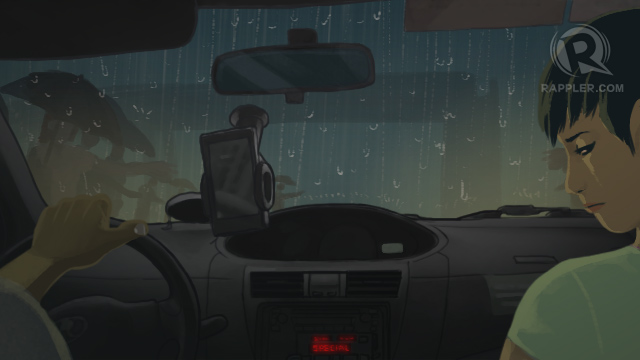SUMMARY
This is AI generated summarization, which may have errors. For context, always refer to the full article.
Here’s a slice of hell many Metro Manilans are familiar with: Friday night. Payday weekend. A strong, steady rain. You are very much aware that if you don’t leave the office before 5 pm, you’ll be swallowed in the scramble of citizens trying to find a ride – any ride – home.
But work took its sweet time with you, and you step out of the office smack-dab in the middle of the rush hour, vehicles gridlocked under the pounding rain, hordes of people stranded on sidewalks with necks craned for a taxi, a bus, a jeep, a horse-drawn buggy, anything.
Recently, however, a breed of mobile apps has provided a way out. The likes of GrabTaxi and EasyTaxi have allowed users to broadcast their need for a ride to a good number of registered cabs puttering nearby, and in turn let cabbies heed their cries if these cabbies prefer certain destinations. A fairly hefty fee, of course, is added to the fare, not to mention that you have to have a decent smartphone and ample load to let the driver know where exactly you’ll be waiting.
But when it works, and a driver catches your bait, it works like a dream. A live map shows an icon of the cab heading your way, and mere minutes after contacting them, you have a comfortable ride with a cabbie who won’t bitch and moan (or only do so inwardly) about your destination and however many traffic jams happen on the way. Even friends and family can access the live map to watch you crawl your way from point A to point B.
For any regular taxi user hardened over years of long waits, heartless competitors (there should be a special place in hell for the ones who beat you to the door, seriously), and self-serving, curmudgeonly cabbies, these apps are godsends, however expensive. Should these services disappear, there will be violent protest.

But no matter how relieved I am to snag a ride this way, the experience always leaves a nasty taste in my mouth. These taxi services are such a stark sign of how decrepit Metro Manila has become. This may sound like I’m stating the obvious, as it’s a pretty established fact that this place is fucked from the ground up, but this particular taxi app phenomenon highlights a new dimension to the sorry saga: technology.
We tend to hail technology as the metro’s potential savior, and we do have a heartening array of projects meant to modernize and alleviate. From umbrella-style government efforts such as the Metro Manila Development Authority’s (MMDA) Traffic Signalization System, to more targeted, citizen-made apps such as sakay.ph, which aims to provide commuters with the most optimal public transportation routes, technology is being harnessed to provide solutions that would benefit the majority. (Whether the MMDA’s system will actually work, however, is a damn good question, but I digress.)
So yes, technology itself, is definitely not the enemy here. But as long as we eagerly embrace the kind of technologies that give even marginally richer citizens a huge advantage, such as these taxi apps, for every forward leap we make, we end up taking two large strides back. As long as I am able to stand before a snaking, seemingly inexhaustible taxi line at the mall, use technology to my advantage, and get a GrabTaxi effortlessly in these people’s (jealous, furious, helpless) midst, Metro Manila will further cement its reputation as the Land of Quick Fixes, a breeding ground for so many band-aid solutions that it has become nothing but a scab.
But how do we discourage people from patronizing things that are so very convenient, which is exactly what technology provides? How do we stop more tech companies from cranking out clever, for-profit projects that take advantage of the metro’s many faults? How do we derail the part of technology that’s speeding in the wrong direction? Clearly, these questions hint loudly at even greater concerns about dictating the role of technology in society (and concerns on commerce, and capitalism, and other isms in general), and I – or most anyone else, really – would be hard-pressed for answers.
For what it’s worth, though, I am confident that becoming aware of the greater repercussions behind developing and embracing certain technologies is a concrete step forward, a bridge for thoughtful action. Will this stop us from opening our taxi apps should we find ourselves in a bind? Probably not. I don’t deny that being a hypocrite is one of the easiest things in the world, especially when you’re alone in an unfamiliar city in the middle of the night, anxious to get home quickly and safely before the rain comes.
Nonetheless, putting your money where your mouth is, is a conscious choice, and technology does far, far more good than harm when harnessed right. And if we really want to see the faintest glimmer of hope for Metro Manila within our lifetimes, it’s definitely not in the middle of an overpriced cab ride, trying not to feel dirty as you speed past commuters who can’t catch a break.
But it can be in the think tank of a tech company, be it a giant or a start-up, when its members decide to be better aware of what they can do, and forego the more profitable project for the more progressive one. It’s in stopping to think carefully, taking the problem into our own hands, and using the technological advantages we enjoy today to do something good for everyone. It sounds cheesy and idealistic for sure, but has anyone ever made anything great without that fire inside them? – Rappler.com
Add a comment
How does this make you feel?
There are no comments yet. Add your comment to start the conversation.